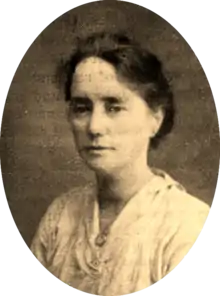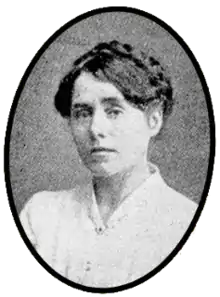Elizabeth O'Farrell
Elizabeth O'Farrell (Irish: Éilís Ní Fhearghail; 5 November 1883 – 25 June 1957)[1] was an Irish nurse, republican and member of Cumann na mBan, best known for delivering the surrender in the Easter Rising of 1916.
Elizabeth O'Farrell | |
|---|---|
 | |
| Born | 5 November 1883 Dublin, Ireland |
| Died | 25 June 1957 (aged 73) Bray, Ireland |
| Nationality | Irish |
| Occupation | Midwife, nurse |
| Known for | The delivery of the surrender of the rebels during the Easter Rising |
Early life
Elizabeth O'Farrell was born on 5 November 1883 in City Quay Dublin, she was the daughter of Christopher O'Farrell who worked at Armstrong's printers and Margaret Kenneah a housekeeper. She was educated by the Sisters of Mercy. Her father died when she was young and she was sent to work. She took a job in Armstrong's a printers in Amiens Street. Her mother had a small shop on the City Quay Dublin.
She was a member of the Sacred Heart and Total Abstinence sodalities. After her education, she became a midwife and joined the national maternity hospital Holles street after her involvement in the 1916 Easter Rising. She was a part of the Gaelic League and became fluent in Irish. In 1906 she joined Inghinidhe na hÉireann alongside lifelong friend Julia Grenan. She also then joined Cumann na mBan the women's branch of the Irish Volunteers after its establishment in 1914.
Easter Rising
O'Farrell acted as a dispatcher before and during the Easter Rising of 1916. She was sent to Athenry to deliver a despatch on Easter Monday. On her return, she reported with her lifelong friend and fellow nurse, Julia Grenan, at the GPO. They were sent around the bullet-torn streets of Dublin during the week with despatches, food and ammunition hidden in their long skirts to stations at Boland's Mill, Powers' Distillery, Jacobs' Factory, St. Stephen's Green and the Four Courts. With Grenan, she also cared for the wounded, including James Connolly. Women and wounded were evacuated from the GPO on the Friday of Easter Week, but O'Farrell, Grenan and Winifred Carney stayed behind with the remainder of the troops, who retreated to a nearby house in Moore Street.
On Saturday, Patrick Pearse chose Elizabeth O'Farrell to seek surrender terms from Brigadier-General Lowe. At 12.45 pm she was handed a Red Cross insignia and a white flag and asked to deliver the surrender to the British military. She emerged into heavy fire on Moore Street which abated when her white flag was recognised. She was taken to Brigadier General William Lowe who sent her back to Pearse at number 16 Moore Street with a demand for unconditional surrender. Pearse agreed and, accompanied by O'Farrell, surrendered in person to General Lowe.[2] A well-known photograph shows Pearse facing General Lowe at the top of Moore Street. Just before the photograph was taken, O'Farrell stepped back. In the original photograph, her feet are visible next to Pearse. This photograph was published 10 days later in the Daily Sketch newspaper.[3] In subsequent reproductions, her feet were airbrushed out.[4] This has led some modern commentators to claim that she was "airbrushed from history".[5] In fact, O'Farrells's role in the surrender was covered in detail in books published throughout the 20th century, such as Dorothy Macardle's The Irish Republic (1937), Max Caulfield's The Easter Rebellion (1963) and Foy and Barton's The Easter Rising (1999).[6][7][8]
Aftermath
Accompanied by a priest and three soldiers, O'Farrell brought the order to surrender, signed by Pearse, to the Volunteer and Citizen Army units at the Four Courts, the College of Surgeons, Boland's Mill and Jacob's factory. Lowe gave her his word that she would not be held as a prisoner after delivering these orders.[2]
O'Farrell was then taken to the Dublin Castle hospital where she was stripped of her clothing and possessions and stayed for one night. The following day she was taken to Ship Street barracks, and was informed was to be sent to Kilmainham jail and held as a prisoner. O'Farrell and some other prisoners were escorted to Richmond Barracks.[2] It was then that O'Farrell noticed Fr. Columbus of Church Street, who had accompanied her to the Four Courts on the evening of 29 April. He told her he would let General Lowe know of her situation.
After being sent to Kilmainham jail she was later released. General Lowe sent a car for O'Farrell to be taken to Dublin Castle where she was to meet him. General Lowe apologised for her detainment and provided her with a letter in case of any further trouble with the military.[2]
Life after The Rising

O'Farrell spent the rest of life working as a midwife and nurse in the National Maternity Hospital, Dublin. When the Irish Government allowed the Bureau of Military History to begin collecting oral history of the Irish Revolutionary period for historical purposes, O'Farrell refused to participate, declaring, "All governments since 1921 have betrayed the Republic."[9]
In the fifties she made speeches on behalf of the republican movement and raised funds for republican prisoners.[10]
Elizabeth died on 25 June 1957[11] while on holiday in Fatima House in Bray, Co. Wicklow and she is buried in the Glasnevin Cemetery next to Julia Grenan in the republican plot.
In modern times, the possibility that Elizabeth and Julia were romantic partners is now strongly considered. The significant closeness they displayed, the fact they lived together for 30 years, the fact that neither was ever married to a man and the fact they were buried beside each other are all considered indicators of a more intimate relationship than publicly stated. Similarly, their comrades in the 1916 rising, Kathleen Lynn and Madeleine ffrench-Mullen are also considered to another "unstated" couple, as was Margaret Skinnider with another woman.[12][13][14][15][16]
Commemorations
-112721_(26033782855).jpg.webp)
After her death, the Nurse Elizabeth O'Farrell Foundation was established in 1967 to help support nursing postgraduate studies. A memorial plaque was also unveiled in Holles Street Hospital where she trained as a midwife from 1920 to 1921.[17] Every year, the hospital awards a student the 'Elizabeth O'Farrell' commemorative award which is a silver medal awarded to a student midwife who exceeds academically in their final exams for qualification as a midwife.[17]
In 2003 another plaque was unveiled in City Quay park commemorating her. O'Farrell was born close by to this area. In 2012, what was originally the City Quay park, is now known as the Elizabeth O'Farrell Park on Sir John Rogersons Quay, Dublin.
In 2016, RTÉ aired a television series giving insight into the Rising for its 100-year anniversary. The series, by RTÉ's Cláracha Gaeilge unit – called Réabhlóid (English: Revolution) – aired four episodes with the final one commemorating Nurse O'Farrell. Episode 4 – 'Famous and Invisible' tells the story of O'Farrell's role in the surrender and looks at how she was allegedly airbrushed out from the original image of the surrender.[18] The episode looks at lesser known characters of 1916 including Elizabeth O'Farrell.
Bibliography
- Hogan, M (2004). Elizabeth O'Farrell and surrender, 1916. Discovering Women in Irish History. Retrieved 21 November 2016, from: 3.1.8 Elizabeth O'Farrell and surrender, 1916
- Brosnan, M. (n.d.) Elizabeth O'Farrell, The National Maternity Hospital. Retrieved 2 February 2018.
- Ni Cheallaigh, L. (Producer & Director) (2016). Réabhlóid. (Motion Picture). Ireland. RTÉ.
- Central Statistics Office. (n.d.) Elizabeth O'Farrell. Census and Women of the Rising. Ireland. CSO. Retrieved 21 November 2016
- Author Unknown. (28 August 2012). City Quay Park now known as Elizabeth O'Farrell Park on Sir John Rogersons Quay, Dublin. Irish Volunteers. Retrieved 20 November 2016 from City Quay Park now known as Elizabeth O'Farrell Park on Sir John Rogersons Quay, Dublin.
- Barry, M. (10 March 2016). Airbrushed from history? Elizabeth O'Farrell and Patrick Pearse's surrender, 1916. The Irish History. Retrieved 10 November 2016 from Airbrushed out of history? Elizabeth O’Farrell and Patrick Pearse’s surrender, 1916.
- Granville, D. (2004). Irish Democrat Archive : Features : The Irish Revolutionary Women of Cumann na mBan. Archive.irishdemocrat.co.uk. Retrieved 22 November 2016, from The Irish Revolutionary Women of Cumann na mBan
- Story of the surrender. (2011, April ). Retrieved 23 November 2016, from 1916 Rebellion Museum | Story of the Surrender
Writings
- O'Farrell, Elizabeth, 'Events of Easter Week', The Catholic Bulletin 1917.
- O'Farrell, Elizabeth & Grenan, Julia, 1972, Memorial Card, Kilmainham Collection (KGC).
Primary sources
- Doherty, Shuna,[19]
- Henderson, Fr Enna, Cistercian Abbey Roscrea, Testimony, 1997, Kilmainham Gaol Collection (KGC)
- Interview with Tove O'Flanagan and Jill Andrews of the National Maternity Hospital 2003.
Secondary sources
- McCoole, Sinead, No Ordinary Women: Irish Female Activists in the Revolutionary Years 1900–1923 (Dublin 2003).
References
- Elizabeth O’Farrell was born 5 November 1883. Her birth was registered “on statutory declaration” 29 April 1884 per C.B. Ball, Assistant Registrar, General Register Office, Dublin. Group Registration ID #10382343, Dublin South, Volume 2, page 750. Retrieved 24 June 2019.
- Frances Clarke and James Quinn (2015). "O'Farrell, Elizabeth" (PDF). Dictionary of Irish Biography.
- "1957 – Death of Elizabeth O'Farrell". Stair na hÉireann / History of Ireland. Retrieved 28 February 2018.
- McGrath, Louisa (25 November 2015). "It's Time to Acknowledge the Lesbians Who Fought in the Easter Rising". Dublin Inquirer. Retrieved 28 February 2018.
- for instance, Cox, Catherine (4 February 2016). "Elizabeth O'Farrell: The woman airbrushed from history". Irish Independent. Retrieved 28 February 2018.
- Macardle, Dorothy (1968). The Irish Republic (3rd (paperback) ed.). Corgi Books. pp. 164–5.
- Caulfield, Max (1963). The Easter Rebellion. Holt, Rinehart and Winston. pp. 274–281. Retrieved 2 March 2018.
- Foy, Michael; Barton, Brian (2004). The Easter Rising (2nd (paperback) ed.). Stroud: Sutton Publishing. pp. 236–40. ISBN 0750934336. Retrieved 2 March 2018.
- Fallon, Donal (8 December 2016). "Deported at 92: The inimitable Joe Clarke". ComeHereToMe.com. Retrieved 21 September 2019.
Elizabeth O’Farrell, the famed nurse of the GPO Garrison who had delivered news of Pearse’s wish to discuss surrender terms to British leaders, refused to give her recollections of the revolutionary period to the Bureau of Military History, on the basis that "all governments since 1921 had betrayed the Republic."
- Rasher Ó Reilly (16 February 2014). "Republican Liam Sutcliffe (Part two)" – via YouTube.
- Central Statistics Office. (n.d.) Elizabeth O'Farrell. Census and Women of the Rising. Ireland. CSO. Retrieved 21 November 2016
- "It's Time to Acknowledge the Lesbians Who Fought in the Easter Rising (with Podcast)". Dublin Inquirer.
- "Hidden Histories: Queer Women of The 1916 Rising | GCN | Gay Ireland News & Entertainment". GCN. 22 March 2016.
- "Wild Irish Women: Elizabeth O'Farrell – A Fearless Woman". 1 February 2017.
- "Lesbians of 1916 are the Rising's 'hidden history'". Independent.ie.
- McGreevy, Ronan. "The gay patriots who helped found the Irish State". The Irish Times.
- Brosnan, M. (n.d.) Elizabeth O'Farrell, The National Maternity Hospital. Retrieved 2 February 2018.
- Ni Cheallaigh, L. (Producer & Director) (2016). Réabhlóid. (Motion Picture). Ireland. Raidió Teilifís Éireann.
- 'Elizabeth O'Farrell and the Women of 1906', Unpublished MA thesis presented to The National Library of Ireland (NLI 1995)